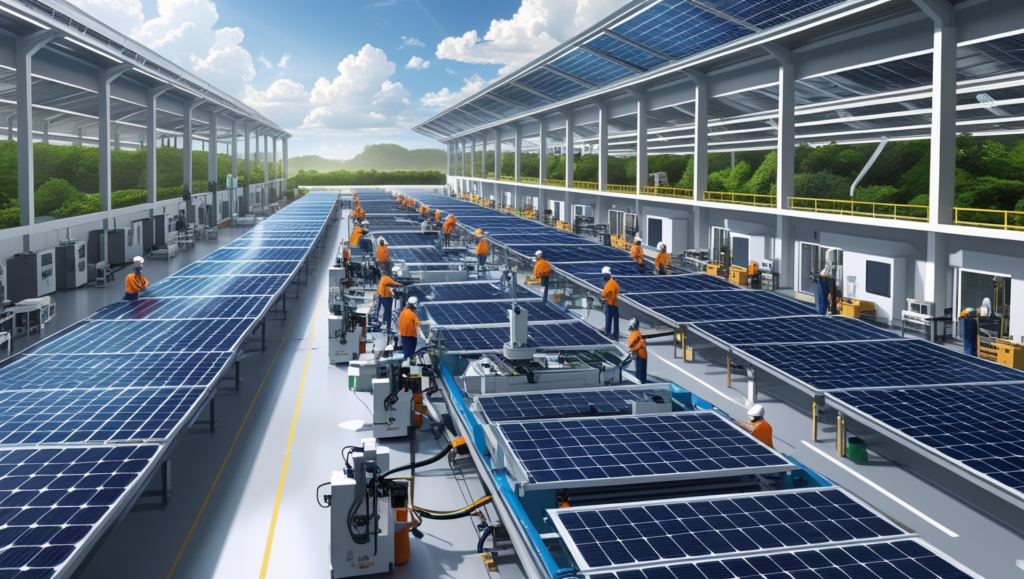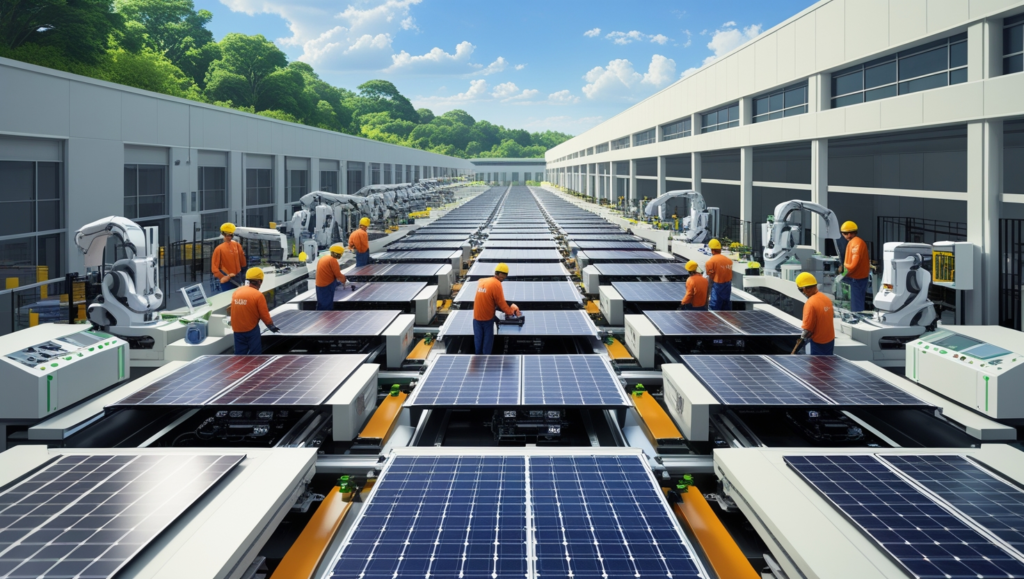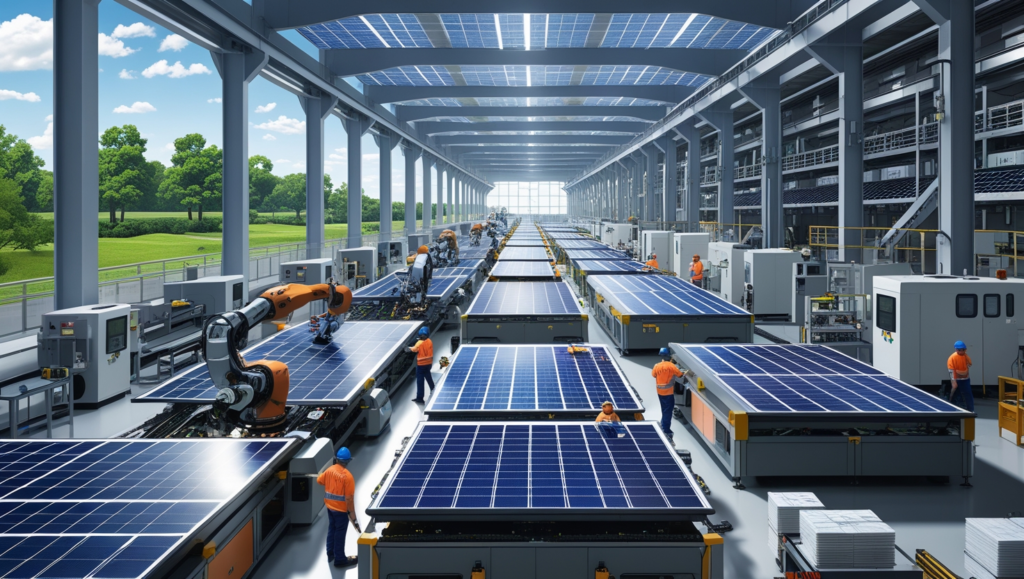In an era where clean energy is at the forefront of global priorities, the U.S. Department of Energy (DOE) has taken a transformative step by approving a $1.45 billion loan for Qcells, a prominent player in the solar panel sector. This investment is earmarked for constructing a cutting-edge solar panel production facility in the United States, a move that underscores the administration’s dedication to advancing renewable energy and reducing dependence on imported solar products.
This initiative is a cornerstone of the nation’s broader strategy to enhance domestic manufacturing capabilities while addressing climate change. By fostering local production, the DOE aims to strengthen the renewable energy supply chain, create jobs, and contribute to national energy security.
The Qcells facility is expected to incorporate innovative technologies and sustainable practices, setting new benchmarks in solar panel manufacturing. This project represents a convergence of economic growth, environmental responsibility, and technological progress, positioning the United States as a competitive force in the global solar market.

A Game-Changing Investment in Solar
The $1.45 billion loan provided by the DOE through its Loan Programs Office marks a pivotal moment for the U.S. solar panel industry. This substantial financial backing allows Qcells to scale up its production capabilities dramatically, paving the way for a new state-of-the-art facility. While the exact location is yet to be finalized, the facility is poised to become a flagship operation for advanced solar panel manufacturing in the United States.
The planned production center will focus on creating high-performance solar panels tailored for both residential and commercial markets. Leveraging cutting-edge manufacturing technologies, Qcells aims to produce panels that are not only more efficient but also more cost-effective, addressing one of the most significant challenges in renewable energy adoption.
By increasing domestic production, this initiative will reduce the reliance on imported solar products, thereby stabilizing the supply chain and ensuring that the U.S. can meet the rapidly growing demand for solar panel solutions. This project is also expected to contribute significantly to the nation’s energy transition goals by delivering solar panels optimized for diverse applications, from powering homes to large-scale industrial installations.
Benefits of the Qcells Project
Boosting Domestic Solar Production
The new Qcells facility is set to transform the U.S. solar manufacturing landscape by significantly increasing domestic production capacity. By reducing the country’s reliance on imported solar panel, this initiative strengthens national energy security and creates a more resilient supply chain for renewable technologies. A robust local manufacturing base ensures that the U.S. can meet its growing energy demands while maintaining control over critical components in the clean energy sector. This shift not only positions the U.S. as a leader in solar technology but also protects the industry from global supply chain disruptions.
Economic Growth and Job Creation
The establishment of the Qcells facility will have a profound economic impact, driving growth and creating thousands of well-paying jobs. During the construction phase, opportunities will abound for skilled workers, contractors, and engineers. Once operational, the facility will require a steady workforce for manufacturing, quality assurance, and logistics. These jobs, spanning various skill levels, will bolster the local economy and establish the region as a hub for renewable energy expertise. Additionally, the ripple effects of this project will benefit suppliers, service providers, and surrounding communities.
Accelerating the Clean Energy Transition
Qcells’ increased production capacity will play a pivotal role in expanding solar energy deployment nationwide. By providing high-quality solar panels for residential, commercial, and industrial applications, the facility will help power homes, businesses, and public spaces with clean, renewable energy. This acceleration in solar adoption directly contributes to reducing greenhouse gas emissions and aligns with the Biden Administration’s ambitious target of achieving 100% clean electricity by 2035. The project is not just an investment in technology—it’s a step toward a sustainable future where renewable energy is accessible to all.

Qcells’ Commitment to Sustainability
Qcells, operating as a subsidiary of Hanwha Solutions, has long been recognized for its dedication to innovation and environmental responsibility. This reputation is further solidified with the development of its new U.S. production facility. A cornerstone of the project is its commitment to sustainable manufacturing practices, ensuring that the facility not only produces clean energy technology but also operates in an environmentally conscious manner.
One key aspect of this commitment is the integration of renewable energy sources to power facility operations wherever feasible. By leveraging solar energy and other green power solutions, Qcells aims to minimize its carbon footprint and set a benchmark for eco-friendly manufacturing in the renewable energy sector. This focus on sustainability ensures that the environmental benefits of solar energy extend beyond its end use, beginning right at the production stage.
Additionally, the facility will prioritize the use of recyclable and sustainable materials in its manufacturing processes. This practice aligns with the principles of a circular economy, where waste is minimized, and resources are reused. By adopting these measures, Qcells not only reduces environmental impact but also positions itself as a leader in responsible manufacturing practices within the solar industry.
Through these efforts, Qcells is demonstrating that sustainability can be seamlessly integrated into large-scale industrial operations. This forward-thinking approach not only supports global climate goals but also enhances the company’s reputation as a pioneer in sustainable innovation, inspiring other manufacturers to follow suit.
The Bigger Picture: DOE’s Role in Renewable Energy
The U.S. Department of Energy’s (DOE) $1.45 billion loan to Qcells is not an isolated initiative but a crucial component of a comprehensive strategy to accelerate the adoption of renewable energy technologies nationwide. This funding, provided through the DOE’s Loan Programs Office (LPO), exemplifies how government resources can catalyze private-sector innovation to tackle the urgent challenges posed by climate change.
The Loan Programs Office has consistently championed transformative energy projects, ranging from cutting-edge battery storage systems to sprawling wind farms. By investing in diverse renewable technologies, the LPO plays a pivotal role in ensuring that the energy landscape evolves to meet modern demands. With this latest investment in solar manufacturing, the DOE is reinforcing its commitment to diversifying the renewable energy portfolio and fostering a resilient clean energy economy.
Beyond supporting individual projects, this initiative highlights the DOE’s broader vision: a future where renewable energy is not only accessible but also instrumental in driving economic growth and environmental stewardship. The agency’s investments are designed to create ripple effects, stimulating technological advancements, reducing greenhouse gas emissions, and fostering job creation across the renewable energy sector.
This loan to Qcells underscores the DOE’s dual focus on innovation and sustainability. By bolstering domestic solar manufacturing, the department is addressing energy security concerns while paving the way for the U.S. to become a leader in renewable energy production. Moreover, the emphasis on green jobs ensures that this transition benefits not just the environment but also the American workforce, creating opportunities in engineering, construction, and advanced manufacturing.
Through robust policy frameworks and targeted funding, the DOE is proving that renewable energy initiatives can drive systemic change. This investment in Qcells is more than a financial transaction—it’s a statement of intent, signaling that the United States is serious about meeting its clean energy goals and setting a global standard for renewable innovation.
Challenges and Opportunities
The establishment of the Qcells facility represents a significant leap forward in the U.S. renewable energy landscape. However, the path to achieving energy independence and scaling solar production is not without challenges. The solar industry, like many sectors, faces hurdles such as supply chain disruptions, intense global competition, and rapidly evolving market demands.
Supply Chain Complexities
The global solar panel industry heavily relies on a complex supply chain for raw materials such as polysilicon, rare earth elements, and advanced manufacturing components. Disruptions caused by geopolitical tensions, trade restrictions, or logistical bottlenecks can impact production timelines and costs. The Qcells facility, by focusing on domestic manufacturing, aims to mitigate these risks by localizing key aspects of the supply chain and reducing reliance on foreign imports.
Global Competition
Countries like China and Germany have long dominated the solar manufacturing industry, offering competitive pricing and advanced technologies. For the U.S. to carve out a significant market share, facilities like Qcells must prioritize innovation, cost-efficiency, and product quality. Leveraging the latest advancements in solar technology and scaling operations effectively will be crucial to competing on a global stage.
Market Dynamics and Evolving Demands
The growing demand for renewable energy is accompanied by shifting customer expectations. Consumers and businesses increasingly seek high-efficiency panels, customizable solutions, and end-to-end energy systems. Qcells will need to stay ahead of these trends, delivering products that meet the diverse needs of residential, commercial, and industrial markets.

Opportunities Amid Challenges
Despite these obstacles, the Qcells initiative opens up significant opportunities:
- Technological Leadership: By employing cutting-edge production techniques, the facility can drive innovations that set new standards for solar panel efficiency and durability.
- Local Job Creation: Addressing labor shortages and upskilling workers in advanced manufacturing techniques positions the U.S. workforce as a cornerstone of the clean energy transition.
- Policy and Incentive Support: With federal and state-level incentives for renewable energy projects, the financial and regulatory environment is becoming increasingly favorable for projects like Qcells.
Positioning the U.S. as a Global Leader
The Qcells facility is not just about producing solar panels; it’s about setting a precedent. By addressing industry challenges head-on and leveraging opportunities, the U.S. is positioning itself as a competitive player in the global renewable energy market. This initiative underscores a broader vision to lead the clean energy transition by fostering innovation, creating jobs, and reducing environmental impact.
Looking Ahead
The $1.45 billion DOE loan to Qcells is more than just a financial investment; it represents a step toward a cleaner, more sustainable future. By prioritizing renewable energy manufacturing, the U.S. is paving the way for economic growth, environmental resilience, and energy independence.
As this project unfolds, it will serve as a blueprint for future collaborations between government and industry, demonstrating the potential of public-private partnerships in transforming the energy landscape.
Conclusion
The U.S. Department of Energy’s $1.45 billion loan to Qcells is a testament to the nation’s commitment to advancing clean energy and strengthening its renewable energy infrastructure. This strategic investment underscores the vital role domestic manufacturing plays in reducing reliance on imported technologies while fostering a robust, homegrown renewable energy sector.
Through this initiative, Qcells will significantly enhance the availability of high-quality solar panels, directly contributing to the country’s clean energy goals. By addressing energy needs with sustainable solutions, the U.S. is not only accelerating its transition to a greener future but also ensuring energy security and economic growth.
Moreover, the collaboration between government funding, private-sector innovation, and community support represents a powerful model for tackling climate challenges. The Qcells project is a shining example of how strategic investments in renewable energy can drive technological advancements, create meaningful job opportunities, and inspire a global shift toward sustainability.
As the U.S. charts its path to achieving 100% clean electricity by 2035, initiatives like the Qcells facility are pivotal. This project doesn’t just meet today’s energy demands; it lays the groundwork for a resilient and sustainable energy future for generations to come.









